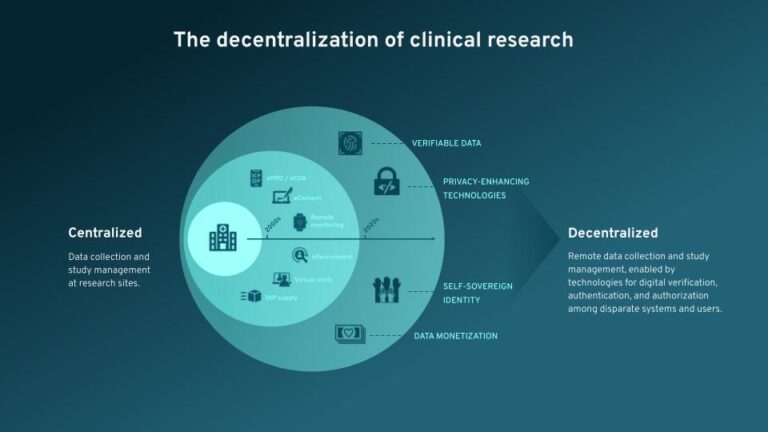The decentralization of clinical research – that is the use of tools and methodologies that allow patients to participate in studies remotely – requires the use of technologies that are still relatively unfamiliar to many. The need to verify data accuracy, ensure privacy, and maintain security of decentralized trial (DCT) approaches calls for advanced technologies like blockchain and the use of self-sovereign identity (SSI) to be effective. Yet a lack of familiarity with these technologies can lead to some hesitation among researchers, despite the proven capabilities of DCT elements to make studies more efficient while providing better patient experiences.
Barriers to the Adoption of Emerging Technologies
People, in general, are slow to change. This is true of industries as well. While the last few years and, specifically, the COVID-19 pandemic, increased the willingness of many industry stakeholders to employ remote technologies, some are still waiting to begin using these approaches at scale. So why is this? There are four key reasons:
- A reluctance to leave the status quo – Just how different is this new way of working, and are we ready for these changes?
- Concerns and (often incorrect) assumptions about cost – Is this an additional cost, does it replace another cost, are their associated costs we don’t yet know about?
- A simple lack of knowledge about the new technology or approach – How do we run DCTs and verify data quality? What are blockchain and SSI anyway?
- A lack of evidence – If the technology is still relatively new, there may not be a lot of comparison data or relevant use cases available yet.
Explaining the Technologies That Make DCTs Work:
Blockchain helps to make study data verifiable while protecting privacy and resisting tampering while creating an interoperable audit trail independent of whatever eClinical systems being used. Blockchain technology transforms clinical study data into what is called a Hash Code – a unique digital fingerprint – which is then stored and timestamped on the blockchain. This way you can see precisely when data was present and that it has not been altered. All data stored on the blockchain cannot be changed, resulting in an immutable and wholly trustworthy audit trail.
Self-Sovereign Identity (SSI) allows us to accurately verify the identities of patients and other key stakeholders from any device and any location, all while preserving privacy. This identity verification is essential for studies that utilize remote data collection. Further, SSI represents the next step in patient-centric research and healthcare in general. Patients are given more control over their health data and receive a single-sign on (SSO) credential that they own which can be used across all different software systems and platforms. This makes solutions like eConsent, eRecruitment, and user training smoother for all involved.
Getting Beyond the Barrier to Realize the Value of Emerging Technology
How do we work to move past these factors that keep us from providing more patient-centric studies and producing more and better study data? Following are some ideas:
- Validation – Research the new approach to evaluate them in terms of quality, time, budget, and user experience. It is critical to involve all possible stakeholders (patients, sites, etc.). If the new approach is to prove useful, it must work well for all parties.
- Education – Inform everyone involved about why the new technology or approach is being implemented and the benefits promised. For patients, perhaps they get the benefit of participating remotely and reducing the need to visit clinics. For sites and sponsors, they get the benefit of more frequent data collection.
- Standardization – Seek out partners that can ensure data interoperability to ensure that all users have the flexibility to move their data as needed while maintaining security and privacy.
- Build Consortiums – Reach out and collaborate with others in the industry who do have more experience with the technologies and approaches you want to use. Share learnings and come up with new uses and innovations together.
Making the Future of Research Possible
As we all strive to build clinical trial experiences that work better for patients, the use of DCT elements will continue to grow. Bringing research closer to the patient can help us make studies more accessible to more widespread and diverse groups of patients, leading to more representative study data and more effective medicines and therapies. Gaining a better understanding of how DCTs work can help to break down the barriers to adoption and allow even more research teams to realize their benefits.




